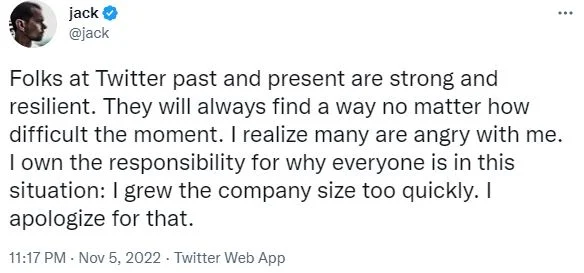On the surface, 2022 was a bleak year of layoffs, stunted growth and tumbling valuations. But could this all be the beginning of something much brighter? What is the outlook for tech industry?

It looks like the tech boom is finally over. But don’t throw your laptop out the window and revert to quill and ink just yet. What is beginning to look like a frugal era for B2C tech, could spell a lucrative new golden age for B2B tech. In this blog we’re going to dissect the last 12 months of tech news, peer deep into the troubled waters of the technology sector and try to make some sense of it all for you. But first, let’s turn back the clock…
It started in spring last year. First Robinhood, then Netflix, Cameo, Carvana, Tesla, Twitter Microsoft. They just kept coming. Cutting 100s, 1000s of jobs. And summer didn’t see much respite for the tech talent haemorrhage. Peloton, 780 jobs cut. Snap, 1,280. But the worst was yet to come, as a Musk-captained Twitter ship tossed 3,700 of its crew overboard, before a large number, having seen the water gushing in around their ankles, chose to jump. Finally, Meta joined the party, slashing 10% of its entire workforce – around 11,000 employees.
So, how did we get here? Can the consumer technology sector pull itself out of the mud? And how much will the needs of these battered and bruised B2C behemoths affect the B2B industry? To get to the bottom of it, we need to address the P word.
The pandemic legacy

The elephant that fills the entirety of the proverbial room here, is the pandemic. The pandemic was a gigantic opportunity for consumer tech. A bored, restless and captive audience, confined to their homes during Covid lockdowns was ready to spend the money they used to spend on travel and generally living life, on new tech.
Because of the kind of activities quarantining customers were limited to, five darlings of the pandemic emerged, here’s why:
Netflix – An obvious one. Trapped indoors with nothing to do? An almost infinite library of film and TV is the perfect antidote. The inclusion of a certain eccentric tiger park owner almost certainly helped them along too.
Zoom – With human contact limited, friends and families had to find new ways of interacting, and businesses needed a way to resume collaboration beyond telephone calls and email. Zoom quickly went from being a stuffy conferencing tool to a household name.
Shopify – eCommerce was on the up and more people than ever were getting involved in side-hustles like drop shipping. Everyone and their aunt seemed to be selling something during lockdown. From handmade trinkets to car parts, Shopify shopfronts skyrocketed.
Wayfair – Spending so much time inside made everyone realise just how much their home needed a makeover. Wayfair was there to provide well-priced, on-trend pieces to satiate even the most ambitious wannabe interior designers.
Peloton – Without rushing for the train, walking about the office all day, and going to the gym, the world needed a new way to stay in shape. Peloton’s combination of tech-fuelled motivation and insights and quality equipment took the world by storm. Who knew working out could be so fun?
But the pandemic, or at least the lockdowns, didn’t last forever. As the world began to return to something resembling normality, consumers had less time on their hands. And after a year stuck inside, the last thing they wanted was to spend it all indoors watching TV and buying furniture. The pandemic darlings plummeted 80% from their mid-pandemic peak.
This was amplified by rising inflation, war in Eastern Europe, rising interest rates and rock bottom customer spending. This had a knock-on effect in tech too. Employees began to return to the office, meaning lower demand for hardware, whilst consumer tech demand dropped off a cliff.
When everyone went back to work, shopping, the pub, the gym, cinemas, gigs, whatever they were doing before, the interest for working out on a stationary bike in your bedroom, or meeting your mates in a VR clubhouse, wore off. Revenue dried up, but organisations had already invested in ambitious new projects and bigger teams. The pandemic gave tech companies an artificial revenue boost. Many weren’t ready when the rug was pulled from under them.
Talent wars
But it wasn’t just dwindling demand and overestimation that caused the ‘tech recession’. For years big tech has been engaged in ‘talent hoarding’. For the last decade, large tech companies prided themselves on hiring and hoarding the most talented individuals ever to sit behind a keyboard. These are the individuals who built the tech landscape we know today.
However, this practice soon became obscene. Tech companies were dangling increasingly large and opulent carrots in front of developers that they deemed to be talented. Any viewers of HBO’s Silicon Valley will recall Nelson ‘Big Head’ Bighetti, being hired by fictional tech megacorp, Hooli, only to sit on the roof terrace and drink smoothies.
After layoffs at Twitter, founder Jack Dorsey tweeted, “I grew the company size too quickly”, whilst Stripe, who sacked 1000 employees, admitted, “We over hired for the world we’re in. We were much too optimistic”.

Let B2B thy saviour
For B2B tech, things have been substantially better. Often seen as sensible older sibling to B2C tech, the sector might not boast dramatic success stories and billion-dollar investments, but it has always offered something that is now becoming more attractive – stability.
During 2022, many large B2C tech companies have uncovered bloated and inefficient processes during these rounds of mass layoffs, and now they’re investing in better infrastructure to improve and save money. So B2B tech staples, such as automation software providers and multi-cloud management system builders, are ready to step in.
Throughout the recession, large corporations are going to be looking inward at their own processes and systems. B2B companies are well positioned to find new clients in this time for reflection and optimisation. Not to mention that the digitisation of businesses is still ongoing, and likely will be for at least the next decade. Put simply, B2B might just save the day here.
Dawning of a new age
So, it’s good news for B2B. From summer 2022, The Drum had already declared a beginning to “B2B’s golden age of growth”. And all the signs are pointing to them being right. In terms of advertising, this year was the first year that B2B Creative Lions ran at Cannes Festival, an award at the festival was previously a privilege reserved for the swanky consumer campaigns.
Here are a few of the reasons we’re going to see big growth in B2B in 2023:
- A helping hand
Newly ‘streamlined’ workforces will need to do more with less – B2B tech has been solving problems like this for SMEs for decades. Whether it’s cloud governance, automation software or something else – many B2B SaaS firms are perfectly positioned to help out.
- A robust investment
Investors who got burnt during last year’s crash are looking for more stable investment opportunities. B2B has proven that it can weather tough economic headwinds and emerge relatively unscathed, even grow.
- New innovation
During the last couple of years, we’ve seen innovative solutions for problems that many didn’t even know existed. There is tons of untapped innovation potential in the sector, and we’re likely going to even more as the sector develops.
A positive tech industry outlook after all
In amongst the doom and gloom of what traditional media are gleefully labelling ‘the burst of the tech bubble’, the outlook for B2B tech sector is looking surprisingly bright. It looks like 2023 should see a continued growth of the sector. Meta, IBM and Microsoft and more are investing in their B2B areas of their businesses too, as it looks like B2B marketing could be entering a golden age.
Layoffs are always horrible. And it was truly devastating to see so many talented people dropped from their roles throughout 2022. But it’s important to look at these layoffs in the context of the chronic over hiring that has been taking place for years. And, as Forbes councils member, Niels Martin Brochner is keen to iterate: “The pandemic gave tech an artificial boost, but it’s still better off now than in 2019 in many ways.
It’s important to look at the events of the last year in context. Once we do, we see that B2B tech is on track for an exciting 2023.
For more tech news and marketing tips, read our blogs.
Looking to get your product in front of business owners who need you?
At Fifty Five and Five, we’ve always believed in this sector. If you’re a B2B tech company of any size, now could be your time. We’ve already helped plenty of small, medium and large organisations deliver campaigns and projects that have helped them achieve big things. Get in touch with our team to see what we can do for you.

